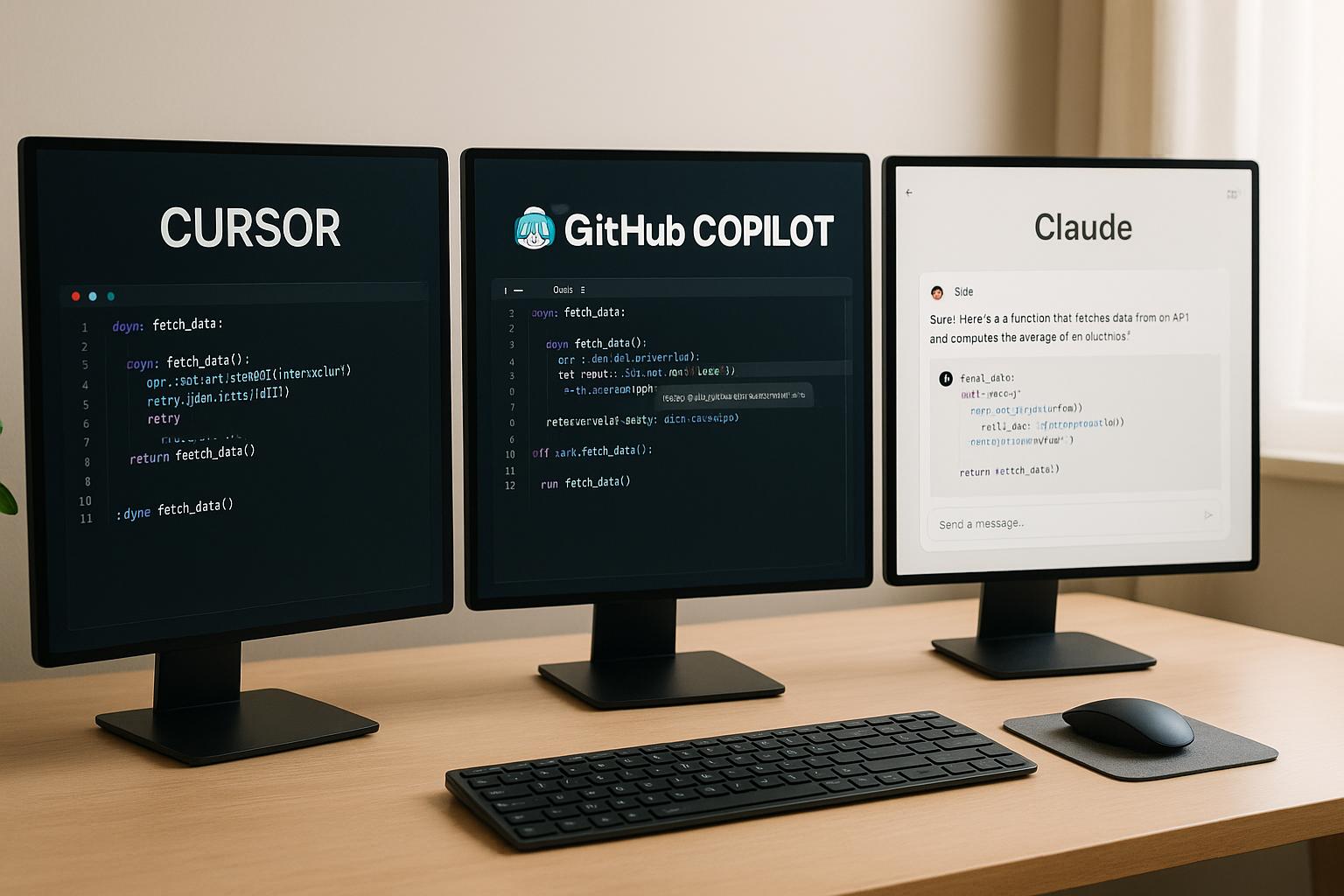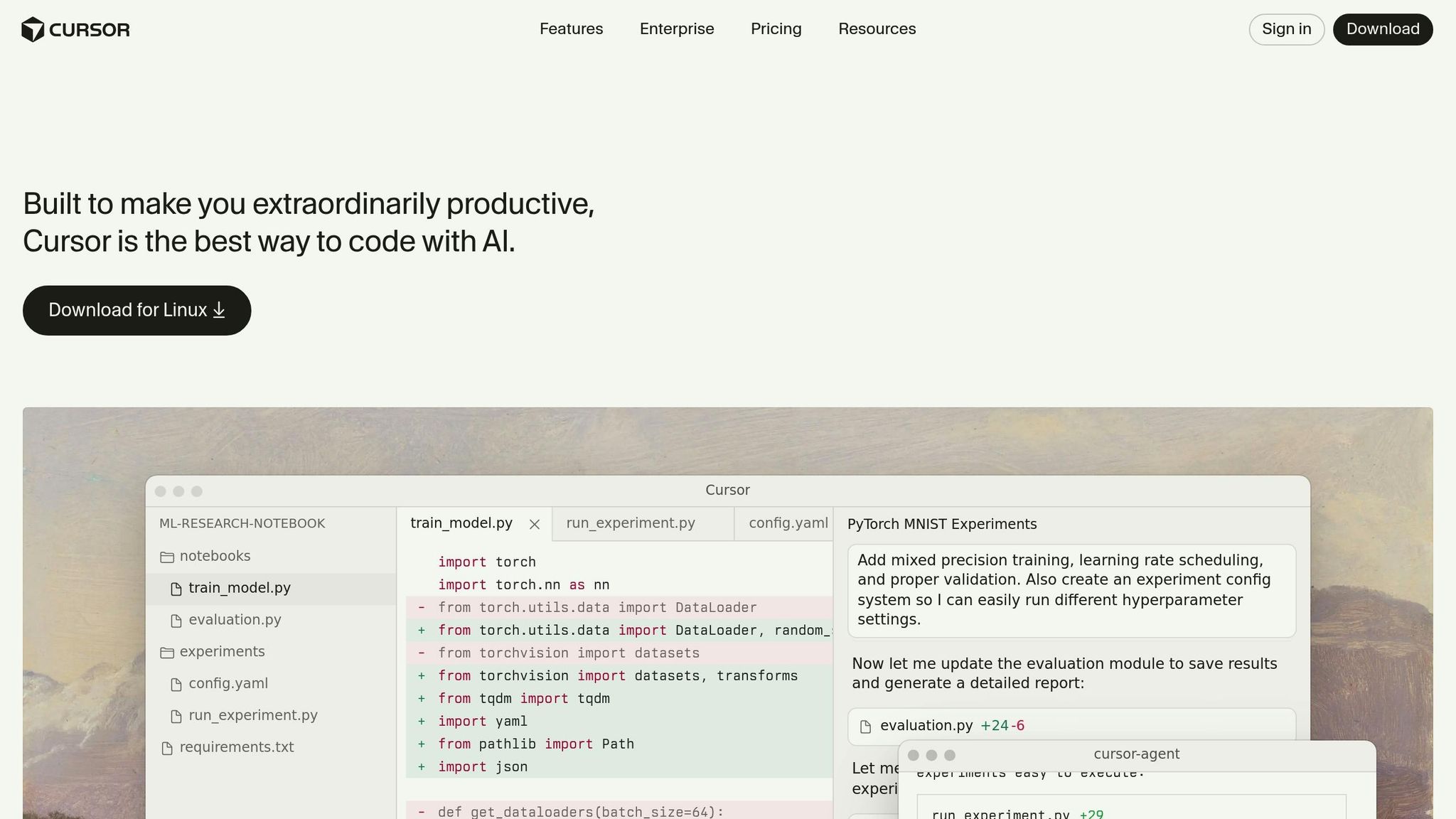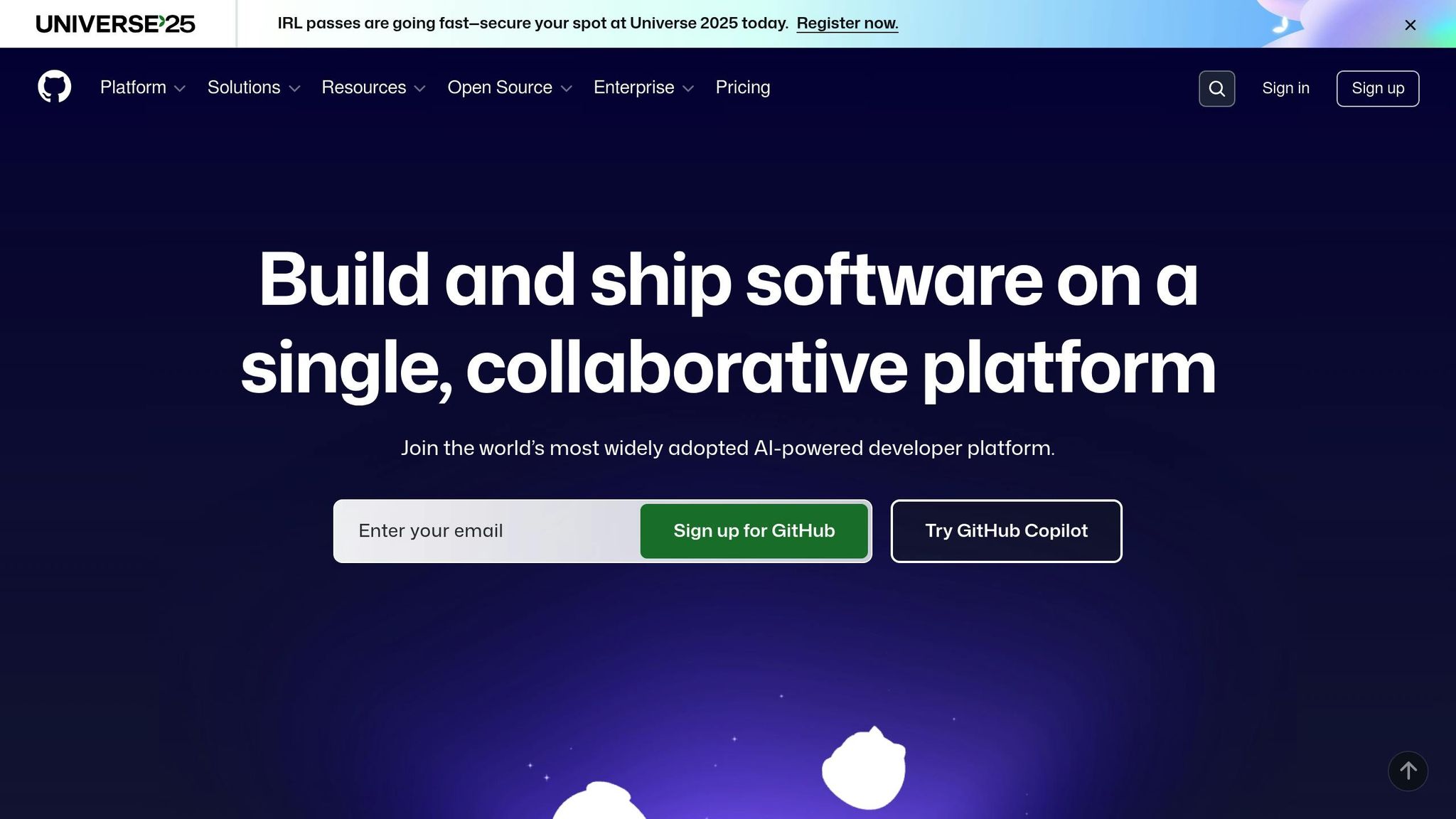Cursor vs GitHub Copilot vs Claude: Which AI Coding Tool Actually Saves Money
Taher Pardawala October 25, 2025
Looking for the best AI coding tool to save money and boost productivity? Here’s the quick answer:
- GitHub Copilot: Best for small teams and startups needing quick, affordable MVP development. Seamlessly integrates with popular IDEs and GitHub workflows.
- Cursor: Ideal for teams dealing with large codebases or complex projects. Its project-aware features reduce technical debt but come with higher costs.
- Claude: Great for individual developers or non-technical founders. Offers deep reasoning and plain-language explanations but lacks strong IDE integration.
Quick Overview:
- GitHub Copilot: Affordable, fast for repetitive tasks, but limited context for large codebases.
- Cursor: Excellent for maintaining consistency across projects but has a steeper learning curve and credit-based pricing.
- Claude: Excels at debugging and code reviews, but slower for routine tasks and less team-friendly.
Quick Comparison Table:
| Tool | Best For | Cost Range | Strengths | Weaknesses |
|---|---|---|---|---|
| GitHub Copilot | Small teams, MVPs | $10–19/user | Affordable, IDE integration | Limited context for big projects |
| Cursor | Complex projects, scaling | $40+/user | Project-aware, consistency | Higher costs, usage limits |
| Claude | Debugging, non-tech users | Variable API | Deep reasoning, plain-language | Less integration, slower routine tasks |
Bottom Line: Start with GitHub Copilot for affordable MVP development. Use Cursor for advanced features in larger projects. Claude is a helpful secondary tool for tackling complex challenges or aiding non-technical founders.
We Tier Ranked Every AI Coding Assistant
Cursor, GitHub Copilot, and Claude: Tool Overview

These AI tools take different paths to speed up development. Knowing their strengths and limitations is key to picking the right one for your startup’s goals and budget. Here’s a breakdown of what each tool brings to the table.
Cursor: Key Features and Applications
Cursor is an AI-powered code editor built on the familiar Visual Studio Code interface, but it takes things up a notch by embedding AI throughout the entire development environment. Unlike plug-in assistants, Cursor makes AI a core part of the experience.
What sets Cursor apart is its ability to analyze multiple files and understand your entire project at once. This makes it a strong choice for tasks like refactoring large codebases or coordinating changes across multiple files. Developers can describe changes in plain English, and Cursor implements them across the project, saving time and effort – especially valuable for startups iterating quickly.
Enterprise adoption has been impressive, with companies like Rippling scaling their engineering teams from 150 to over 500 while using Cursor [2]. However, since Cursor requires its own standalone application, teams with heavily customized IDE setups might face some challenges transitioning.
GitHub Copilot: Key Features and Applications

GitHub Copilot works as an extension for popular IDEs like VS Code, JetBrains, and Visual Studio. It integrates directly into your existing workflow, offering AI-driven code suggestions as you type.
Beyond inline suggestions, Copilot also features a chat function for conversational interactions. Its seamless integration with GitHub makes it an excellent fit for teams already using GitHub for version control and project management.
Copilot has seen wide adoption, with 82% of enterprises reportedly using it [1]. That said, it does have some limitations, such as an 8,192-token cap that can hinder performance on very large codebases [2].
Claude: Key Features and Applications
Claude takes a different approach, operating through chat interfaces and command-line tools rather than integrating into an IDE. Developers can interact with Claude via web, Slack, or CLI tools to solve coding problems, generate code, and analyze entire codebases.
One of Claude’s standout features is its ability to process up to 200,000 tokens, with outputs reaching up to 128,000 tokens. This makes it especially useful for handling massive codebases, conducting deep architectural reviews, and making strategic decisions on complex projects.
Claude Code also works directly in the terminal and integrates with tools like Figma, Jira, and Slack, providing flexibility for teams that need more than just code generation. With a 53% adoption rate, Claude leads in overall usage, and nearly half of organizations (49%) subscribe to multiple AI tools. Interestingly, over 26% use both GitHub Copilot and Claude together [1]. This suggests that Claude’s chat-based model often complements IDE-integrated tools.
Additionally, the chat-based interface makes Claude accessible to non-technical founders, helping them understand code and make decisions without diving into intricate development environments.
Pricing Breakdown and Cost Analysis
When managing a startup budget, understanding the pricing models of different tools is essential. Pricing structures can vary significantly, affecting monthly expenses based on usage levels and team size. Here’s a closer look at the costs and features tied to each tool.
Monthly Costs and Pricing Plans
GitHub Copilot follows a tiered subscription model, offering plans like Free, Pro, Pro+, Business, and Enterprise [4][5]. The Pro+ plan, for instance, includes 1,500 premium requests per month, making it a solid choice for users with heavy demands.
Cursor uses a credit-based pricing system with options ranging from a free Hobby tier to Pro, Pro+, Ultra, Teams, and Enterprise levels [5][6]. This setup provides flexibility for projects that might have fluctuating needs.
Claude, on the other hand, is accessed through its chat interface or integrations, rather than through traditional subscription tiers [3][7].
Cost vs Features: What You Get for Your Money
GitHub Copilot offers consistent pricing with broad integration across various IDEs [4][5]. Its fixed subscription plans, especially the Pro+ tier with its 1,500 premium requests, cater to teams that need reliable AI support.
Cursor’s credit-based model is ideal for teams with changing AI requirements. It allows users to scale costs according to periods of higher or lower activity [5][6].
Claude stands out for its adaptability as a multi-purpose AI tool. It’s particularly useful for non-technical founders, helping them make informed decisions while offering more than just coding assistance [3][7].
Generally, higher-tier plans provide better value per request and access to advanced AI features [5]. Startups must weigh the need for predictable costs against the benefits of premium features to boost workflows and speed up MVP development.
sbb-itb-51b9a02
Development Speed and Code Quality Impact
When evaluating AI coding tools, it’s not just about the price tag – how much time they save and the quality of code they produce play a huge role in determining their overall value. The real benefit of these tools lies in their ability to speed up development while ensuring the code remains maintainable. Each tool takes a unique approach to balancing these factors, and those differences can have a noticeable impact on your startup’s efficiency and long-term costs.
How Each Tool Speeds Up Development
GitHub Copilot shines when it comes to completing code snippets and even entire functions. By recognizing common patterns and generating boilerplate code instantly, it’s particularly helpful for repetitive tasks like setting up API endpoints, database queries, or CRUD operations. This makes it a go-to for routine coding.
Cursor, on the other hand, offers a more project-aware approach. It understands your entire codebase, enabling it to suggest changes across multiple files while maintaining consistency. This makes it especially useful for tasks like refactoring or handling multi-file updates, reducing the chances of integration hiccups.
Claude stands out for its dialogue-based debugging. Beyond just suggesting code, it explains the reasoning behind its solutions, helping developers understand trade-offs. This educational aspect can be a game-changer when tackling complex issues, saving time that would otherwise be spent researching or debugging unfamiliar patterns.
The time saved depends on the type of work. Repetitive tasks see the biggest gains, while more complex decisions – like designing architecture – still require human oversight. While these tools offer immediate productivity boosts, their impact on long-term code quality is just as important.
Code Quality and Long-Term Maintenance
Code quality has a direct impact on how easy (or costly) it is to maintain software. For example, GitHub Copilot generates code that often follows established patterns, which helps with consistency. However, since its suggestions are based on training data that includes both good and bad practices, developers need to carefully review its output to avoid introducing technical debt.
Cursor excels in maintaining consistency across your project. By aligning its suggestions with your existing codebase, it minimizes style conflicts and ensures smoother maintenance in the future. Its ability to understand your project’s context makes it less likely to propose solutions that clash with your architecture.
Claude focuses on transparency, explaining and justifying its recommendations. This clarity empowers developers to make informed decisions about whether to adopt or tweak its suggestions. It’s also helpful for identifying potential issues during code reviews or refactoring, adding another layer of quality control.
Here’s a quick comparison of how these tools stack up:
| Tool | Development Speed Pros | Development Speed Cons | Code Quality Pros | Code Quality Cons |
|---|---|---|---|---|
| GitHub Copilot | Fast completion, great for boilerplate code, broad IDE support | Limited project context, may suggest outdated patterns | Follows common patterns, ensures consistent formatting | Can inherit poor practices from training data, requires review |
| Cursor | Context-aware suggestions, supports multi-file refactoring | Steeper learning curve, credit-based usage limits | Maintains consistency, architecture-aware solutions | Less effective outside supported environments |
| Claude | Offers educational debugging, explains solutions clearly | Requires more interaction, less IDE integration | Transparent reasoning, identifies code issues well | Slower for routine tasks, needs integration |
Teams that prioritize tools with a focus on consistency and clarity often find themselves dealing with less technical debt over time. On the flip side, tools that prioritize speed without much regard for quality can lead to higher maintenance costs later. For startups working on MVPs, finding the right balance between immediate productivity and long-term maintainability can make the difference between scalable growth and a technical bottleneck that slows progress as the team expands.
Best AI Tool for Different Startup Needs
Choosing the right AI tool for your startup can save both time and money while steering clear of unnecessary headaches. Each tool caters to specific needs, so understanding these distinctions is crucial.
Top Choice for Non-Technical Founders
For founders without a technical background, Cursor shines as the most accessible option. Its plain-language code explanations help non-technical users stay engaged without diving into complicated trade-offs or technical jargon. This transparency allows founders to remain involved in the development process, even without coding expertise. In contrast, GitHub Copilot requires a level of technical familiarity, as its inline suggestions are better suited for those with a coding background.
Now, let’s look at the tools that speed up MVP creation.
Best Tool for Fast MVP Creation
When it comes to quick idea validation, GitHub Copilot is a standout. It’s particularly effective at generating boilerplate code, which is often the backbone of most MVPs, making it a great fit for startups on lean budgets. However, Cursor offers faster prototyping – research suggests it can reduce development time by 40–60% [8]. This makes it a strong contender for more complex MVPs that require advanced functionality.
If clean, well-documented code is a priority, Claude is worth considering. Its ability to produce polished code from the outset minimizes the need for extensive refactoring later. Many startups in competitive markets adopt a hybrid approach, using GitHub Copilot for basic tasks while turning to Cursor for more demanding feature development.
Ultimately, your choice depends on the complexity of your MVP. For simple proof-of-concept projects, Copilot’s speed and affordability are ideal. On the other hand, if your MVP is designed to scale quickly, Cursor’s higher price tag can be justified by the reduction in technical debt down the line.
As your startup grows, collaboration becomes a key factor.
Team Growth: Collaboration and Workflow Integration
When transitioning from a small team to a larger organization, seamless workflow integration becomes essential. GitHub Copilot offers one of the smoothest integrations, fitting naturally into existing GitHub workflows – a tool already familiar to many startups in the U.S. Research from an Accenture partnership found that 90% of developers reported increased productivity with Copilot [2], making it a reliable choice for scaling teams.
Cursor, with team plans starting at $40 per user per month (including approximately 500 agent requests) [2], provides project-aware capabilities that are particularly useful for maintaining consistency in larger codebases. This consistency helps prevent architectural drift as teams grow. However, its higher costs and usage limits can become a concern for expanding teams.
Claude, on the other hand, struggles with integration in team environments. Its chat-based interface doesn’t align well with the collaborative workflows that scaling teams typically require. While individual developers may appreciate its deep reasoning capabilities for tackling complex problems, it’s less practical for daily team operations.
| Tool | Best Team Size | Cost per User | Collaboration Strengths | Scaling Challenges |
|---|---|---|---|---|
| GitHub Copilot | 3–50+ developers | $10–19/user predictable | Native GitHub integration, familiar workflows | Limited project context across large codebases |
| Cursor | 2–20 developers | $40+/user with usage costs | Project-wide consistency, shared context | Higher costs and usage limits may surprise growing teams |
| Claude | Individual contributors | Variable API costs | Deep reasoning, educational value | Chat interface hampers team integration |
With 82% of developers worldwide already using AI-powered coding tools [8], selecting the right tool early can help you avoid costly migrations later. For U.S. startups following agile methodologies, GitHub Copilot offers a smooth and familiar integration with minimal disruption. Meanwhile, startups building complex products can benefit from Cursor’s upfront investment, which pays off through reduced technical debt and faster development of advanced features. The key is finding the right balance between cost and collaborative efficiency to ensure long-term productivity.
Final Verdict: Which Tool Delivers the Best Value
The best tool for your startup ultimately depends on your specific needs and where you are in your growth journey.
If you’re a budget-conscious startup working on a simple MVP, GitHub Copilot is a solid choice. Its predictable subscription pricing and seamless integration with GitHub make it a reliable option for lean teams focused on productivity without breaking the bank.
For non-technical founders or teams looking for project-aware features, Cursor stands out. It simplifies coding with plain-language explanations and helps reduce development time and future refactoring costs. While its usage-based pricing may be higher, the time saved can often justify the investment.
Claude shines as a complementary tool rather than a primary coding solution. Its strengths lie in educational support and solving complex technical challenges, making it particularly useful for individual developers tackling tough problems. However, its chat-based interface and variable pricing may not suit larger teams or serve as the main development tool.
To balance cost, productivity, and integration, many U.S. startups might find it practical to start with GitHub Copilot for early-stage development. As projects grow and evolve, exploring Cursor for its advanced features could be a smart move. By aligning each tool’s strengths with your immediate priorities, you can manage costs effectively while supporting your startup’s growth.
FAQs
How can GitHub Copilot’s integration with popular IDEs help small teams and startups save time and money?
GitHub Copilot works effortlessly with popular IDEs, providing real-time code suggestions to help developers code faster and with less hassle. This means small teams and startups can spend more time tackling challenging problems instead of getting bogged down by repetitive tasks.
Beyond that, Copilot can automatically generate boilerplate code and take care of routine coding chores, cutting down development time and trimming costs. With its compatibility across multiple programming languages and frameworks, it’s a handy tool for a variety of projects, allowing startups to develop and refine their products with greater speed and efficiency.
What makes Cursor a good choice for managing large codebases?
Cursor is built to simplify the challenges that come with managing large codebases. It helps developers organize, standardize, and refactor their projects with ease. Key features include Chat, which assists in navigating and understanding unfamiliar code, and the ability to create custom rules tailored to specific domain knowledge. Its project file tools also enhance planning and execution, making it an essential resource for handling complex development tasks efficiently.
When would Claude be a better choice than GitHub Copilot or Cursor for individual developers?
Claude stands out as a strong choice for individual developers when dealing with complex codebases or tackling architectural challenges. It shines in tasks such as breaking down intricate code, solving multi-step problems, and assisting with large-scale refactoring projects.
For developers handling extensive or complicated codebases, Claude’s knack for delivering detailed insights and context-aware recommendations can be a real time-saver while minimizing errors. This can be especially helpful for those maintaining legacy systems or navigating tough debugging scenarios.








Leave a Reply